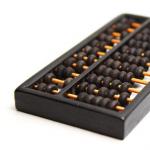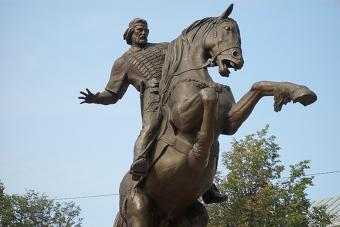· 04.10.2014
The text of the article was updated: 12/13/2018
A couple of weeks ago, I posted a photo report about a trip to the Old Believer village of Nizhneirginskoye in the Krasnoufimsky district in the south of the Sverdlovsk region. He told how the photo was taken with goats on the outskirts of the village. But, if you think that I only drove small cattle there in the Ural mountains, then you are greatly mistaken! I also thought, what would be interesting to amuse you, dear readers ... I know that among the site visitors a significant share is occupied by beginners who have recently bought their first DSLR. I hope you find it helpful to know some advice on how to photograph beautifully. By the road I noticed a bunch of dried up thistle flowers - the symbol of Scotland. I was not too lazy to chop off my hands, pluck the flowers and put them in the trunk of my car. And all in order to prepare a free photography lesson for owners of Nikon SLR cameras, Sony mirrorless cameras and, I'm not afraid of this expression - fans of "boots", that is, Canon DSLRs. Today we are learning to shoot flowers against a black background in natural light from a window together.
To begin with, it should be noted that I do not know how to shoot flowers at all. That is why I say that we will learn to photograph together. And for what I did, I ask you not to rush with tomatoes and rotten cats ... Maybe after reading my article, you will be able to significantly improve my achievements and shoot your masterpiece ...
So, a little bit of theory about what are the general recommendations of professionals for shooting flowers in any conditions.
- As in many other cases, it is strongly discouraged to photograph flowers from above. We all, more often than not, look at plants from this angle, and it is commonplace. If we want to surprise the viewer, grab his attention, we need to use other shooting points, non-standard: at eye level, from bottom to top, and the like. By the expression "as in other cases" we mean, for example, photographing children, dogs and cats. If we lie on the floor and shoot our beloved Tuzik on our Canon EOS 650D from the level of his eyes or from the bottom up (he is on the couch, we are on the carpet), then the photo will turn out to be somewhat more interesting than that of ordinary people.
- It would be nice to use a macro lens or telephoto lens for shooting flowers. Macrik gives excellent detail, telephoto blurs the background well. Some photographers advise using a macro lens or macro filter to capture flora. The blog has an overview of Close-Up macro filters and examples of plant photos on them. But to be honest, I'm not very good at using these devices. Other amateur photographers, for example, Ekaterina Stupnikova, whose examples of photographs taken with Nikon D3100 and fifty Nikkor 50 / 1.8G are found several times on the pages of this site, takes simply mesmerizing photos using Close-Up lenses.
- As in any other genre of photography, if we want to photograph a masterpiece, there is nothing to shoot in hard light. We shoot on the street - we are waiting for the "golden hour" for landscape photography, or we photograph flowers with our amateur Canon EOS 1100D camera in the shadow of a building, or we shade them with our body. Also, you can use a translucent material as the source of the shadow. For example, a white satin fabric stretched over a flower bed. Gorgeous photos are obtained when shooting a flower in a back color. You can be convinced of this by looking at excellent examples of photographs taken with a Nikon D3200 SLR camera with different lenses (Helios, Nikkor 105 / 2.8 macro lens) by amateur photographer Yulia from Saratov.
- Cool shots can be taken after rain or at dawn. Moreover, rain can be imitated by sprinkling a flower from a spray bottle. And the secret is that it is better to use not just water, but a glycerin solution (you can buy it at a pharmacy), which forms a denser molecular film. Therefore, the droplets will be larger and more stable than those of water.
- When we try to photograph beautifully flowers in the open air, and even during working hours, there is a problem of wiggling due to the wind: the plants sway. I don't want to set a high ISO to avoid digital noise, but there is not enough light and, as a result, a long exposure is required. So that there is no lubrication, you need to fix the flower somehow. Some photographers carry clothespins with which they attach the plant to a peg. Also, in an interview with one well-known professional photographer, he advised, if we are serious about shooting flowers, to make a folding screen made of transparent material (polypropylene film, for example), which can be used to shield our object. This solution will allow you to hide the flower from the wind, and not spoil the background.
These are the general recommendations of professionals on how to shoot flowers beautifully. But now it's autumn, cloudy, rainy and wet. And you don't really want to lie down on the ground (if you managed to buy a camera without a tilting screen) in order to choose the best angle on your Nikon D3300 SLR camera. Seriously, you are so clean that you are afraid to get dirty when photographing masterpieces? Well then - you go to the bathhouse !!!
And also about.
Of course, in a graphics editor, if the photographer has the necessary skills, you can transplant an object to any background. The question is how long will it take. If while shooting there is an opportunity to get this or that background or effect in the background, it is better to do this than spend time on post-processing.
If everything is clear and logical with a white background - in order to get a white background when shooting, you need to illuminate it more than the object, then getting a black background when shooting is associated with the inverse task.
In short, the principle of obtaining a black (or close to black) background can be formulated as follows: for the background to turn black, the subject must be exposed normally, and the background must be underexposed so as not to be fixed on the sensor (or other light-sensitive material). Simply put, you need to illuminate the subject, but not illuminate the background.
So, I took a picture of this bottle first in natural light, in a normal room in my apartment. There is a bottle on black acrylic, and the background is light wallpaper on the wall, they just did not fall into the depth of field. That is, I do not have a black background.
Now, in fact, the order of actions:
You need to determine the exposure at which the background will turn black. To do this, set the M mode, shutter speed equal to the sync speed (usually 1/200 - 1/250 sec), ISO to minimum, then select the aperture to completely cut off natural light. I got an aperture of f / 11, with some margin. So, I got the following camera parameters: ISO 100, f / 11, 1/200 s. With these values, I am guaranteed to get a black background.
Next, you need to adjust the flash power in such a way as to properly expose the subject. I should note that this method is not suitable for shooting with a built-in flash or an external flash that is attached to the camera.
I used simple scheme lighting with one source. On the left there is a softbox, the light source of which is a Canon 580 EX II flash, controlled by a radio synchronizer. It is very important to place the softbox as close to the subject as possible, so as not to increase the flash power unnecessarily, and most importantly, to reduce the intensity of light reflection from the walls to the background.

Now, another very important point: the distance between the background and the object must be significantly greater than the distance between the object and the light source! The principle is simple - the inverse square law. Who does not know - please use the site search. My distance from the softbox to the bottle was about 30 cm, and from the bottle to the background (wall) - 2.5 meters. Here's a little brain training: Calculate the difference in illumination between the subject and the background?
And finally, to completely eliminate the possibility of light directly from the softbox on the background, I put a black flag next to the softbox. Shirmochka, simply put. Now I can be sure that when shooting I will get a black background or as close to black as possible.
Easier, of course, is to get a black background using impulse sources light, but with constant light this is also possible. It is only advisable to work in a darkened room and carefully control the spread of light.
The main principle is that light should only be where it is needed. If we need a black background, we cut off the light from it. As a result, any background becomes black.
Finally got around to writing this little lesson about the question that I get asked very often - how do these same portraits on a black background turn out? What does the grid have to do with it?
In general, what is the main feature of portable flashes?
In my opinion - to transform habitual peace, the ability to make it others almost anywhere you choose. And first of all, this applies to a portrait with the "exclusion" of external lighting, when the photograph is one person, without the surrounding interiors and objects. It's one thing to come to a photo studio, where everything is adjusted to get a "high-quality photo" and there is nothing superfluous - just a bunch of huge expensive equipment and monophonic backgrounds in special mounts. And another thing is to get a similar shot in a few minutes in a friend's apartment, in an office, at a picnic, in a gym, in the shade of trees ... but anywhere ..))Well, for example - we take an unshaven unshaven uncle (only a month and a half ago it was - how long it took the hairdresser not to cut it all! ;)) , we ask where his first camera is, we give it to him, and in an ordinary room we take several shots with two small flashes:
To obtain such portraits, it takes five minutes to set up two stands with flash units, and five minutes to shoot. No trips to the studio, no long hassles - in fact, people are comfortable with this kind of quick filming. And the result always evokes the same reaction: "Oh, how is that! It's not dark right there! I like it ..." ..))
In fact - yes, you do not need to turn off the light, look for some special places... Here's what and where these pictures were taken:
It does not matter at all what color the wall is behind, what is hanging on it, what objects are placed around - as a result, they simply are not in the photograph, because the light from the flashes is concentrated exclusively on the person.
But - there is still a small secret: these are those little black nozzles on the heads of the flashes, which are called " grid" or simply " honeycomb nozzle". A couple of months ago I did a small review of Micnova light modifiers, where I also talked about these accessories.
The main task of the grid in this technique is to direct the light only to the model and prevent it from spreading to the surrounding environment (by the way - the frame with the racks was taken with a flash on the camera, its light was reflected from the wall - and the black background did not work). And the settings of the camera, of course, in the manual mode "M", should be such that the light from lamps, windows, etc. did not appear in the picture. For example, a shutter speed of 1 / 160-200 sec and an aperture of f / 8-11 at ISO100 is sufficient. Try to take a picture with such settings in an apartment with the lights on or the curtains open - you will probably just get a black frame (unless the direct daytime sun hits the window). This is our "black background" ..))
It is powerful to do without grids, but only in very large rooms - sports / assembly / conference halls - or outdoors on a cloudy day, where the light from the flashes has nothing to reflect from. But in standard rooms, such as apartments, offices, etc. the grid is becoming an indispensable tool.
For comparison, we made several versions of the shots in the same place with different parameters.
Flash on the camera aimed at the ceiling and pulled out a white business card
Compare this frame with the first one in the article (then we have already removed Zenith to its legitimate shelf - after all, we are not talking about it) - how does it make a difference to you? And this is taking into account that the background is uniform. What if it was a funky floral wallpaper or something worse? ;)The light is normal - but boring ... By the way, the face / profile is not for the police protocol :), but to give a comparison with the first three options, where there is both a front view and a side view in Hamlet's pose ..))
Two flashes on stands without honeycomb attachments
We removed the grids from the flash units (they remained in their places) to show what frames would be obtained without these modifiers in the same place.The first test - the zoom of the reflector of both Yongnuo YN-560s is set to a wide illumination angle - 24 mm... Of course, the light from direct flashes is hard, in contrast to the soft from the ceiling, but now we are talking about drawing and excluding the background from the frame.
In this trial, the "profile" was forgotten - but nothing, it's okay ..))
As you can see, at such a wide zoom, the light from the flashes hits both the model and the entire environment - you can't get a black background like that.
And what will happen if you set the narrowest angle of illumination that can be done -ki - 105 mm- maybe the beam of flares will be so narrow that no reflexes will be given to the walls and surroundings?
As you can see, the lighting angle is still large enough and some of the light hits the wall. To get a black background in this place, the flash beam is not narrow enough ...
Two flashes on stands with honeycomb heads
Putting grids on the flashes again and we get the following result:I think now you understand the mechanism of shooting a portrait on a black background without the blackest background ..))
Finally, a few important points
- I am by no means saying that this is the only way to shoot with portable flash units - this is a cool technique, but one of many!
- There can be one, two, three flashes; grids - on all or only on those that are directed towards surfaces and objects that may fall into the frame. This lighting arrangement is not the only one - experiment!
- Flashes without large modifiers (
Every photographer who is engaged in studio shooting sooner or later comes across a situation when he needs to shoot a black object on a black background. The subjects can be very different: it can be shooting an object, an animal with black fur, or, for example, a creative portrait with black bodypainting. In any of them, the photographer needs to achieve the main thing - to avoid the obvious failure of details and excessive merging of the subject with the background. With the right technical approach, shooting dark objects against a dark background will allow you to get very stylish footage.
Let's first figure out what black is. By definition, black is the darkest color resulting from the absence or complete absorption of visible color. For each of us, black symbolizes complete darkness - it is not surprising that in the RGB system black is symbolized by three zeros (0,0,0). Imagine a situation if both the background and the actual subject are completely black. You probably already guessed that they will merge with each other into one dark spot. Therefore, our first priority as photographers is to visually separate the subject from the background. This can be done in several ways.
1 Backlighting
The easiest way to visually “bounce off” a black object from a black background is to add backlighting to the frame, that is, create visible contours along the edges of the object separating it from the background. As an example, I will cite a portrait of a black Newfoundland that I made with Veronika Ershova at one of our master classes.
In this portrait, three Hensel Expert D500 pulse monoblocks were used as back light sources at once. One with a beauty dish and honeycomb was suspended from the top and back, creating a small light “cap” on the head, and the other two with strip boxes were placed on the back sides to create additional contour. Remember that black actively absorbs light, so you may need a little more source power than usual to create a visible outline. Please note: in those areas where the light hits the object, the color ceases to be completely black and becomes gray. Light accents and brightness differences appear on the object, which ultimately form the volume so necessary in the frame. That is why I did not highlight absolutely all black areas on the dog, for example, on the forehead.
In such a scheme, the light should always be set from contractors. Thus, at first, with the help of backlighting, I bounced the model off the background and created volume on the sides, and then I supplemented the areas I needed with painting light and filled the shadows with a reflector.

A variety of backlight attachments can be used. For side "contractors" photographers often use narrow strip-boxes, for top illumination solutions may vary depending on the task. When working with backlighting, avoid backlighting by using honeycombs to help focus the light beam, or black flags to cut out unnecessary light.

Here's another example of working with backlighting and a black background. This time all the work in the frame is done exclusively by the "contractors". For this creative look, Veronika Ershova and I made a black hat with chains, which makes our model in the frame a knife shape. At the same time, the model is dressed in a black bodysuit so that the main focus in the frame is on the improvised blade. In this shot, I used a black background and two long strip-boxes, almost as tall as the model, to create even outlines on the sides and make the chains glow.

2 Creating a difference in brightness between subject and background
As I said above, if the subject and the background are equally black in the frame, they will merge into one spot, so we need to visually separate them from each other. In addition to using backlighting, such a separation can be carried out by a banal division of brightness between your subject and the background: in other words, we can brighten both the background and the object itself. As a rule, in such cases, the subject is made slightly lighter than the background. Remember that the viewer primarily pays attention to the brightest parts of the image, and it will be very strange if an uninteresting background is chosen as an accent. Moreover, a bright background should be avoided if the object has a texture that must be shown in the frame. Accordingly, here we deceive the viewer a little: the light makes a black object gray, and visually this already separates it from the background.

Take a look at this shot of two Belgian griffons. In this case, they are separated from the background precisely by the brightness difference - the black color on the muzzles is quite highlighted, which creates the necessary accent on them. In addition, the background color has been lightened slightly, which also helps to separate the subjects from the background.

3 Using background lighting
Working with background lighting when shooting a black subject against a black background is essentially another option for creating a difference in brightness. But, as a rule, when using backlighting, we create an emphasis on the area of the background we need, without affecting the entire background. For example, you have the following task - you need to visually separate the face of the model in the portrait from the background. To do this, we put on a standard reflector honeycomb, put the source behind the model and shine into the background in the area we need. At the same time, try not to overdo it with the brightness of the light spot, otherwise it will pull all the attention in your frame.
Date of publication: 31.08.2017
This article continues the series of lessons on studio subject photography. Earlier, we studied the features of shooting glass on. Now let's consider the specifics and possible difficulties when photographing glass against a dark background.
As you remember, all glass objects have varying degrees of transparency and let light pass through them. In advertising object photography, the photographer must convey the color of the content (if any), as well as the volume and shape of the glass object itself.
Earlier, we found out the following: in order for the contents of a glass bottle to play, it must be removed "in the light". You can read about this in the article. There are practically no difficulties in such shooting. But what if you need to remove glass against a dark background?

Sometimes in image shooting the contents of the bottle are not so significant, the form and silhouette come first, due to which the composition is built. To do this, you just need to place the object being shot on a black background and behind it, slightly to the side, put 2 stripboxes, which will create beautiful even highlights along the contour of the glass object (Scheme 1). You can also take one large softbox and glue it in the middle with a sheet of thick black cardboard (diagram 2).
When taking a photo with a glass, only one stripbox on the left side was enough, since, due to the light-refracting properties of the liquid, the wine in the glass was highlighted with a juicy scarlet highlight on the right, and the main contour highlight on the left of the glass was also reflected on the right side, emphasizing the shape.


But what if you need to convey not only the shape and silhouette of the bottle, but also its contents?
 NIKON D800 / 85.0 mm f / 1.8 SETTINGS: ISO 160, F11, 1/200 s, 85.0 mm equiv.
NIKON D800 / 85.0 mm f / 1.8 SETTINGS: ISO 160, F11, 1/200 s, 85.0 mm equiv.
In some cases, the contents of glass objects are dense enough to illuminate them with only front or side light and not shoot "in the light".
In this case, you can be guided by the same principles as when shooting glossy objects and use one of the 4 schemes that we discussed with you in the previous lessons.

Scheme No. 1: Two stripboxes on the sides of the subject to create crisp highlights on both sides
Scheme No. 2: two reflectors shining through frost filters create soft tinted highlights on both sides
Scheme No. 3: a stripbox creates a clear flare on one side, and a reflector shining through a frost filter creates a soft shaded flare on the other
Scheme No. 4: the stripbox creates a clear highlight on one side, and the reflector lights up the object slightly on the other
But sometimes the liquid in the glass has a very low density, and it becomes insufficient to illuminate it with only the front and side light, since a black background shines through it.

In order to make this kind of liquid "play" on a black background, there is one little secret.
It is necessary to cut out a piece of foil that matches the shape of the subject of photography, but a little smaller, and place it on the back. You can try gluing the foil directly to the glass on the back wall using a small piece of double-sided tape. Or place it a little further, using a small stand for this. The foil will reflect the front and side light and illuminate the liquid from the inside. Depending on the location of the foil, you can adjust the brightness and saturation of the liquid backlight.
In the examples below, you can see the difference between how different liquids look in glass, shot on a black background without using foil (photo on the left) and using it (photo on the right).




I use my full-frame Nikon D800 camera in almost all my shots. She always pleases me with excellent clarity and detail of the resulting photos. High resolution and good headroom give you full control and editing of your images in post-processing.
I shoot product photos with Nikon AF-S NIKKOR 24-120mm f / 4G ED VR, Nikon AF-S NIKKOR 85mm f / 1.8G and Nikon AF-S VR Micro-Nikkor 105mm f / 2.8G lenses and am also very pleased with their quality. ...





